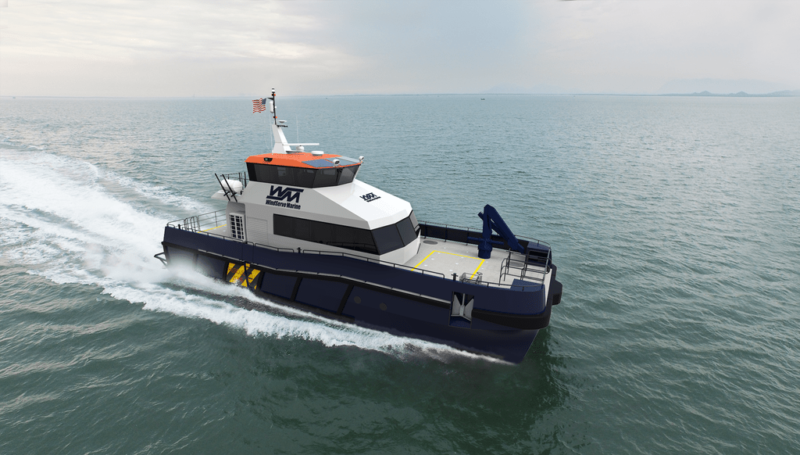Designers of crew transfer vessels (CTVs) for offshore wind energy face a number of challenges – starting with the core mission of delivering workers in speed and comfort to turbines at sea.
In the emerging U.S. offshore wind industry there’s another unique demand: working safely around migration routes of the highly endangered northern right whale.
“It’s something we’ve not come across yet in Europe as we don’t have this right whale issue,” said James Lewis, project manager for specialized ship design at BMT, leading a design team behind the first CTVs being built for Ørsted offshore wind developments in U.S. waters.
A CTV fleet will be critical to the ambitious plans of state energy planners and wind developers to build out turbine arrays. A U.S. wind industry will need thousands of skilled new workers during the 2020s, according to the National Ocean Industries Association, and CTVs will need to bring them and materials to offshore construction sites.
The builders will need to work around the whales, monitoring their movements and likely suspending some operations, such as pile driving, when the animals are nearby.

A North Atlantic right whale with calf. NOAA photo
The National Oceanic and Atmospheric Administration and scientists estimate only 411 northern right whales survive along the East Coast. The animals faced extinction in 1992 when the population hit a low of 295, before increasing to around 500 by 2010.
But the population has produced few young in this decade, while enduring further losses to ship strikes and entanglement in fishing gear.
As an effort to reduce mortality, NOAA uses aerial surveys and sightings of right whales to chart their movements, and announces “seasonal management zones” to alert vessel operators to whales in those areas. The agency calls for 10-knot speed limits on vessels larger than 65’ when they operate in the shifting management areas.
That’s a major issue for wind developers, because prime locations for turbines on the outer continental shelf often overlap with whale habitat. A 10-knot speed limit would negate the primary mission of crew transfer vessels: delivering technicians to the worksite quickly, in good condition, and not seasick.
After almost three decades of development, CTVs for the European market area getting bigger as companies install larger and more powerful turbines. The most powerful now at 9.5 megawatts will be eclipsed in just a few years by designs like the GE Haliade 12 MW turbine some in the industry foresee machines of 20 MW by 2030.
The need for more crew and cargo capacity, speed and comfort on CTVs “grows and grows along with the industry, from 16, 17 meters…our wind farm vessels now are up to 26 and 27 meters,” said Lewis. The designers were looking at a similar size for the U.S. market that would have been around 85’.
“Then it comes out down the line about these seasonal closed areas for right whales,” said Lewis.
The catamaran will carry 20 passengers plus four crew, at top speed around 28 knots, with power from four Scania engines of around 800 hp each. The designers are using Tier 3 power because compressing speed and functionality into the 20-meter hull form leaves little room for the bulk of a Tier 4 exhaust treatment system, said Lewis.
“The emphasis has always been on speed, comfort, get them out there,” said Lewis. With this design “if it’s 50 miles offshore you can get there in two hours.”
Having two engines in each hull gives “redundancy and a huge amount of power,” he said. “It can get you home safely if it loses two or even three engines.”
The first boat is under construction at U.S. Workboats, Hubert, N.C., for delivery in early 2020. The operator will be WindServe Marine, an affiliate of the New York-based Reinauer Group, and the second CTV will be constructed at its affiliate shipyard Senesco Marine, located at Quonset Point, the former Navy base and now a marine industrial hub in North Kingstown, R.I., for delivery in late 2020.
The BMT designed vessels will be the second and third in U.S. service, following the Atlantic Pioneer, delivered in 2016 by Blount Boats, Warren, R.I., for duty on Ørsted’s Block Island Wind Farm. The new CTVs will work first on Ørsted’s Coastal Virginia Offshore Wind Project, a pilot project with Dominion Energy for two 6-megawatt turbines, and then move on to other Ørsted projects in the Northeast.
In a June 7 letter to members of Congress, Randall Luthi, president of the National Ocean Industries Association, urged the House Committee on Natural Resources to support bill H.R. 3068 to support an offshore wind training grant program to build the workforce that will ride CTVs.
“Although there are existing domestic businesses already engaged in offshore wind development, the U.S. will need thousands of skilled new workers over the next decade, both onshore and offshore, to make a thriving offshore wind industry a reality,” Luthi wrote.
Luthi noted a recent University of Delaware report that predicts $70 billion in capital expenditures through the 2020s.
“By establishing a federal grant program to assist colleges, universities, unions and nonprofits to develop programs, training and internships, we can advance the development of a skilled offshore wind workforce,” he wrote.




